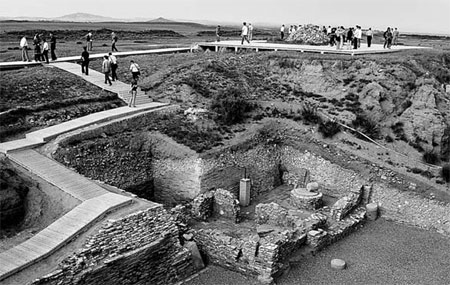UNESCO makes Xanadu a World Heritage Site
Updated: 2012-07-02 07:48
By Zhang Zixuan (China Daily)
|
|||||||||
|
Tourists visit a site of Xanadu in the Inner Mongolia autonomous region last year, which was added to the World Heritage List on Friday. Jia Lijun / Xinhua |
Friday marked a historic day for the Site of Xanadu in the Inner Mongolia autonomous region as it gained a place on the World Heritage List.
That announcement came at the 36th session of the UNESCO's World Heritage Committee in Saint Petersburg, Russia.
China's only candidate for World Cultural Heritage status this year is the first to be in Inner Mongolia, as well as the country's 42nd World Heritage site and 30th World Cultural Heritage site.
"Xanadu is the best-preserved among the Yuan (Dynasty's) capital cities and has lasted the longest," said Tong Mingkang, deputy director of State Administration of Cultural Heritage.
"It's the only intact evidence of the rise and fall of the Yuan Dynasty (1271-1368), which witnessed the unique fusion of agrarian Han Chinese and nomadic Mongolian civilizations in northern Asia."
Lying in Zhenglan Banner and Duolun county of the Xilin Gol League in central Inner Mongolia, Xanadu was the first capital of Kublai Khan (1215-94) and later became the summer capital of the Yuan Dynasty.
Six of 11 Yuan emperors ascended to the throne in Xanadu. But the city was destroyed in fires over the course of a decade starting in 1358 and eventually abandoned.
Shaped like a square, Xanadu has a central axis marked by an imperial city and a palace city, which is surrounded by an outer city. When the Yuan Dynasty moved its capital to Beijing, it built the Forbidden City in a position that aligned it with Xanadu's axis.
Archaeological explorations have uncovered the underground remains of the old capital, which had been covered by grasslands. Since 2008, archaeologists have confirmed the discovery of 1,078 building sites, 700 construction foundations and 29 large streets.
"Some of the city's attributes, such as its water drainage system, were already quite advanced compared with what we have today," said Tala, curator of the Inner Mongolia Museum and director of the Xanadu archaeology team.
Some of the cultural relics - for example, white marble columns bearing dragon designs and three-color glazed roof tiles - were evidence of the high aesthetic standards that were observed at the time, Tala said.
Archaeologists have also found Christian churches, mosques and Buddhist temples beneath the grassland. The tombs of Europeans have meanwhile been discovered in Zhenzi Mountain in Duolun county.
"Xanadu had a profound and long-lasting influence on relations between the East and West, and has inspired literary and other creative works throughout the centuries," Tong said.
The Venetian traveler Marco Polo (1254-1324) is believed to have come to China around 1275 and to have gained an audience with Kublai Khan in the palace of Xanadu. When he returned home years later, the tale of his adventures was told in what became the book The Travels of Marco Polo.
In 1797, the English romantic poet Samuel Taylor Coleridge (1772-1834) wrote his well-known poem Kubla Khan, which was inspired by a dream he had after a reading from a book that took The Travels of Marco Polo as its source on Xanadu. Published in 1816, the poem inspired many in European and American with a yearning to visit the city.
Webster's New World College Dictionary defines the word "Xanadu" as referring to "any luxurious or exotic mansion, estate, etc".
The Site of Xanadu started on its journey toward being named a World Heritage site in 1996.
"As this had to do with the first steppe city to be nominated on the Inner Mongolian Plateau, we couldn't refer to past experiences," said Qiqige, deputy-director of the Xanadu World Heritage Nomination Team. "Our team had to forge its own path."
Various steps have been taken to prepare the site to receive its recently bestowed honor.
Regulations have been enacted to ensure it is protected legally.
Electrical equipment within the nominated property area has been buried to ensure the site's original appearance is maintained.
A meteorology observatory station has been built next to the site to monitor environmental changes. Various security measures have been adopted. And the team has established the Xanadu Site Museum to preserve cultural relics excavated from the ruins.
"All the signs within the site are written in Mongolian, Chinese and English," said Gao Hua, director of the Zhenglan Banner Administrative Bureau of Xanadu Site.
More archaeological excavations are also under way at the site. Visitors can now go to places where such work has already taken place, to the Mingde Gate, Yutian Gate, Da'an Pavilion and Muqing Pavilion.
"Work-in-progress archaeological works are also a special feature for visitors," Tala said, adding that the archaeological crews only work from June to early October, when the weather tends to be good.
zhangzixuan@chinadaily.com.cn
(China Daily 07/02/2012 page4)

 Relief reaches isolated village
Relief reaches isolated village
 Rainfall poses new threats to quake-hit region
Rainfall poses new threats to quake-hit region
 Funerals begin for Boston bombing victims
Funerals begin for Boston bombing victims
 Quake takeaway from China's Air Force
Quake takeaway from China's Air Force
 Obama celebrates young inventors at science fair
Obama celebrates young inventors at science fair
 Earth Day marked around the world
Earth Day marked around the world
 Volunteer team helping students find sense of normalcy
Volunteer team helping students find sense of normalcy
 Ethnic groups quick to join rescue efforts
Ethnic groups quick to join rescue efforts
Most Viewed
Editor's Picks

|

|

|

|

|

|
Today's Top News
Health new priority for quake zone
Xi meets US top military officer
Japan's boats driven out of Diaoyu
China mulls online shopping legislation
Bird flu death toll rises to 22
Putin appoints new ambassador to China
Japanese ships blocked from Diaoyu Islands
Inspired by Guan, more Chinese pick up golf
US Weekly

|

|








